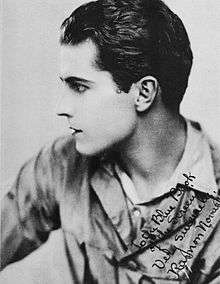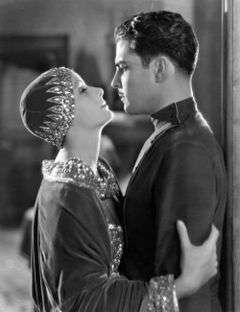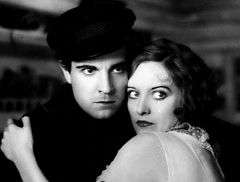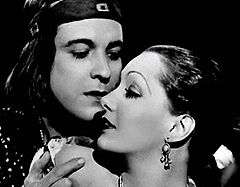Ramon Novarro
| Ramón Novarro | |
|---|---|
 Ramón Novarro in 1922 | |
| Born |
José Ramón Gil Samaniego February 6, 1899 Durango, Mexico |
| Died |
October 30, 1968 (aged 69) North Hollywood, Los Angeles, California, U.S. |
| Cause of death | Asphyxiation (murdered) |
| Resting place | Calvary Cemetery |
| Other names |
|
| Years active | 1917–1968 |
| Awards |
Hollywood Walk of Fame - Motion Picture 6350 Hollywood Boulevard |
Jose Ramón Gil Samaniego, best known as Ramón Novarro (February 6, 1899 – October 30, 1968), was a Mexican-American film, stage and television actor who began his career in silent films in 1917 and eventually became a leading man and one of the top box office attractions of the 1920s and early 1930s. Novarro was promoted by MGM as a "Latin lover" and became known as a sex symbol after the death of Rudolph Valentino.
Early life
Novarro was born José Ramón Gil Samaniego on February 6, 1899 in Durango, Mexico, to Dr. Mariano N. Samaniego, and his wife, Leonor (Gavilan).[1] The family moved to Los Angeles, California, to escape the Mexican Revolution in 1913.[2] Novarros's direct ancestors came from the Castilian town of Burgos from where two brothers emigrated to the New World in the seventeenth century.[3]
Allan Ellenberger, Novarro's biographer, writes:
[...t]he Samaniegos were an influential and well-respected family in Mexico. Many Samaniegos had prominent positions in the affairs of state and were held in high esteem by the president. Ramon's grandfather, Mariano Samaniego, was a well-known physician in Juarez. Known as a charitable and outgoing man, he was once an interim governor for the State of Chihuahua and was the first city councilman of El Paso, Texas...
Ramon's father, Dr. Mariano N. Samaniego, was born in Juarez and attended high school in Las Cruces, New Mexico. After receiving his degree in dentistry at the University of Pennsylvania, he moved to Durango, Mexico, and began a flourishing dental practice. In 1891 he married Leonor Pérez-Gavilán, the beautiful daughter of a prosperous landowner. The Pérez-Gaviláns were a mixture of Spanish and Aztec blood, and according to local legend, they were descended from Guerrero, a prince of Montezuma.[4]
The family estate was called the "Garden of Eden". Thirteen children were born there: Emilio; Guadalupe; Rosa; Ramón; Leonor; Mariano; Luz; Antonio; José; a stillborn child; Carmen; Ángel and Eduardo.[4] At the time of the revolution in Mexico, the family moved from Durango to Mexico City and then back to Durango. Three of Ramón's sisters, Guadalupe, Rosa, and Leonor, became nuns.[5] He was a second cousin of the Mexican actresses Dolores del Río[6] and Andrea Palma.
Career
Silent films

He entered films in 1917 in bit parts. He supplemented his income by working as a singing waiter. His friends, actor and director Rex Ingram and his wife, the actress Alice Terry, began to promote him as a rival to Rudolph Valentino, and Ingram suggested he change his name to "Novarro." From 1923, he began to play more prominent roles. His role in Scaramouche (1923) brought him his first major success.
In 1925, Novarro achieved his greatest success in Ben-Hur. His revealing costumes caused a sensation. He was elevated into the Hollywood elite.[7] As did many stars, Novarro engaged Sylvia of Hollywood as a therapist (although in her tell-all book, Sylvia erroneously claimed that Novarro slept in a coffin).[8] With Valentino's death in 1926, Novarro became the screen's leading Latin actor, though ranked behind his MGM contemporary, John Gilbert, as a leading man. He was popular as a swashbuckler in action roles and considered one of the great romantic lead actors of his day. Novarro appeared with Norma Shearer in The Student Prince in Old Heidelberg (1927) and with Joan Crawford in Across to Singapore (1928).

Talking films
He made his first talking film, starring as a singing French soldier, in Devil-May-Care (1929). He starred with Dorothy Janis in The Pagan (1929), with Greta Garbo in Mata Hari (1931), with Myrna Loy in The Barbarian (1933) and opposite Lupe Vélez in Laughing Boy (1934).
When his contract with MGM Studios expired in 1935 and the studio did not renew it, Novarro continued to act sporadically, appearing in films for Republic Pictures, a Mexican religious drama, and a French comedy. In the 1940s, he had several small roles in American films, including We Were Strangers (1949), directed by John Huston and starring Jennifer Jones and John Garfield. In 1958, he was considered for a role in the television series The Green Peacock, with Howard Duff and Ida Lupino, after their CBS Television sitcom Mr. Adams and Eve (1957–58). The project, however, never materialized. A Broadway tryout was aborted in the 1960s. Novarro kept busy on television, appearing in NBC's The High Chaparral as late as 1968.
At the peak of his success in the late 1920s and early 1930s, Ramón Novarro was earning more than US$100,000 per film. He invested some of his income in real estate, and his Hollywood Hills residence is one of the more renowned designs (1927) by Lloyd Wright, the son of Frank Lloyd Wright.[9] When his career ended, he was still able to maintain a comfortable lifestyle.

Personal life
Novarro was troubled all his life by his conflicted feelings toward his Roman Catholic religion and his homosexuality.[10] His life-long struggle with alcoholism is often traced to these problems.[11][12][13] MGM mogul Louis B. Mayer reportedly tried to coerce Novarro into a "lavender marriage", which he refused.[14] He was romantically involved with journalist Herbert Howe, who was also his publicist in the late 1920s.[15]
Along with Dolores del Río, Lupe Vélez and James Cagney, Novarro was accused of promoting Communism in California. It happened after they attended a special screening of the film ¡Que viva México! by famed Russian filmmaker Sergei M. Eisenstein.
Murder
Novarro was murdered on October 30, 1968, by brothers Paul and Tom Ferguson, aged 22 and 17, whom he had hired from an agency to come to his Laurel Canyon home for sex.[16][17] According to the prosecution in the murder case, the two young men believed that a large sum of money was hidden in Novarro's house. The prosecution accused the brothers of torturing Novarro for several hours to force him to reveal where the non-existent money was hidden. They left the house with $20 they took from his bathrobe pocket. Novarro died as a result of asphyxiation—having choked to death on his own blood after being beaten.[18] The two perpetrators were caught and sentenced to long prison terms, but released on probation in the mid-1970s. Both were later re-arrested for unrelated crimes for which they served longer prison terms than for the murder of Novarro.[19] Scotty Bowers' 2012 autobiography Full Service: My Adventures in Hollywood and the Secret Sex Lives of the Stars provides questionable details about Novarro's death.[20]
In a 1998 interview, Paul Ferguson finally assumed the blame for Novarro’s death. He emphasized that he and Tom had not gone to the home to rob the elderly film star, although they trashed his home as a ruse, to make police believe robbery had been the motive. They knew nothing of a supposed $5,000 that Novarro kept stashed behind a portrait in his home. Paul Ferguson blamed internal homophobia for the rage that led him to pummel Novarro. “When he [Novarro] kissed me, I reacted like a Catholic, what they call homosexual panic… It had nothing to do with Novarro, nothing to do with his being homosexual. It all had to do with how I saw myself. And the fact that my brother was there. And that he could see me in that homosexual act”.[21] The brothers were arrested and convicted for numerous crimes over the years, including a 1987 rape of a 54-year-old woman. Tom Ferguson committed suicide on March 6, 2005 by slitting his throat in a motel. He left no suicide note. Paul Ferguson eventually published a collection of autobiographical short stories in 2009 titled No More War Stuff About God, Anymore. In a 2012 interview, Paul Ferguson stated: “As far as Mr. Novarro, I came to peace with that a long time ago,“I’m at peace with: what happened. It was not intentional; it was an accident. I’m not at peace that a human being is dead and I was a part of that. That has haunted me. I never deliberately hurt Mr. Navarro. I am absolutely responsible, but it’s not the things that you do, it’s the things you do intentionally. It’s who you are. You have a lot of shit written on your brow with your regrets. And I don’t know what role it played in my brother Tommy’s suicide either. I have to wonder about that”. Paul maintains that there was no murder weapon. He states, “I’ll tell you what, I’m a boxer. When I hit you, I probably hit you three or four times. I remember standing beside this man and coming out of this heavy drunken fog and hitting him and seeing him fall on the bed. But I didn’t do anything more than that. Mr. Novarro died because he was so drunk...that the involuntary muscle in his throat didn’t work because the alcohol suppressed it. If he had turned his head, if he had been a little more sober, he would not have died. That’s the God’s truth.” Of Tom's involvement, Paul says, “Basically nothing. He was supposed to be staying there. He was on the phone to his girlfriend, and he heard me hit Novarro. Next thing, I was sitting on the couch and I went back in the front room. I poured a drink and sat down on the couch and I dozed off and he came in there and said, ‘You gotta come with me.’ And I went in there, and he pointed at Novarro and said, ‘This guy’s dead.’ Mr. Novarro was lying on the floor, and we picked him up and put him on the bed. Then we got the brilliant idea: Let’s make it look like a robbery”. Paul is currently serving a sentence of 60 years for a 1989 rape and sodomy charge.[22]
Ramón Novarro is buried in Calvary Cemetery in Los Angeles. Ramón Novarro's star on the Hollywood Walk of Fame is at 6350 Hollywood Boulevard.
In popular culture
Novarro's murder served as the basis for the short story by Charles Bukowski called The Murder of Ramon Vasquez, as well as for the song "Tango," by Jerry Leiber and Mike Stoller, recorded by Peggy Lee on her Mirrors album.
In late 2005, the Wings Theatre in New York City staged the world premiere of Through a Naked Lens by George Barthel. The play combined fact and fiction to depict Ramon Novarro's rise to fame and his relationship with Hollywood journalist Herbert Howe.
Novarro's relationship with Herbert Howe is discussed in two biographies: Allan R. Ellenberger's Ramón Novarro and André Soares's Beyond Paradise: The Life of Ramón Novarro.
Prize-winning Greek playwright Pavlos Matesis wrote a play in two parts titled "The Ghost of Mr. Ramon Novarro", which was first staged at the National Theatre of Greece in 1973.[23]
Filmography
| Year | Title | Role | Notes |
|---|---|---|---|
| 1916 | Joan the Woman | Starving Peasant | Uncredited |
| 1917 | The Jaguar's Claws | Bandit | Uncredited |
| 1917 | The Little American | Wounded Soldier | Uncredited |
| 1917 | The Hostage | Uncredited | |
| 1917 | The Woman God Forgot | Aztec man | Uncredited |
| 1918 | The Goat | Uncredited | |
| 1921 | A Small Town Idol | Dancer | as Ramón Samaniego |
| 1921 | The Concert | Dancing shepherd | Uncredited |
| 1921 | The Four Horsemen of the Apocalypse | Guest at Ball (extra) | Uncredited |
| 1921 | Man-Woman-Marriage | Dancer | Uncredited |
| 1922 | Mr. Barner of New York | Antonio | as Ramon Samaniego |
| 1922 | The Prisoner of Zenda | Rupert of Hentzau | as Ramon Samaniegos |
| 1922 | Trifling Women | Henri/Ivan de Maupin | |
| 1923 | Where the Pavement Ends | Motauri | |
| 1923 | Scaramouche | André-Louis Moreau, Quintin's Godson | |
| 1924 | Thy Name Is Woman | Juan Ricardo | |
| 1924 | The Arab | Jamil Abdullah Azam | |
| 1924 | The Red Lily | Jean Leonnec | |
| 1925 | A Lover's Oath | Ben Ali | *lost; but A.M.P.A.S. has 25 feet of this film |
| 1925 | The Midshipman | Dick Randall | |
| 1925 | Ben-Hur: A Tale of the Christ | Judah Ben-Hur | |
| 1927 | Lovers | José | |
| 1927 | The Student Prince in Old Heidelberg | Crown Prince Karl Heinrich | |
| 1927 | The Road to Romance | José Armando | |
| 1928 | Across to Singapore | Joel Shore | |
| 1928 | A Certain Young Man | Lord Gerald Brinsley | |
| 1928 | Forbidden Hours | His Majesty, Michael IV | |
| 1929 | The Flying Fleet | Ens./Ltjg Tommy Winslow | |
| 1929 | The Pagan | Henry Shoesmith, Jr. | |
| 1929 | Devil-May-Care | Armand | |
| 1930 | Le chanteur de Séville | Juan | French version of Call of the Flesh |
| 1930 | In Gay Madrid | Ricardo | |
| 1930 | The March of Time | Himself | Unfinished film |
| 1930 | Call of the Flesh | Juan de Dios | |
| 1930 | Sevilla de mis amores | Juan de Dios Carbajal | Spanish version of Call of the Flesh |
| 1931 | Daybreak | Willi Kasder | |
| 1931 | Son of India | Karim | |
| 1931 | Mata Hari | Lt. Alexis Rosanoff | |
| 1932 | Huddle | Antonio "Tony" Amatto | |
| 1932 | The Son-Daughter | Tom Lee/Prince Chun | |
| 1933 | The Barbarian | Jamil El Shehab | |
| 1934 | The Cat and the Fiddle | Victor Florescu | |
| 1934 | Laughing Boy | Laughing Boy | |
| 1935 | The Night Is Young | Archduke Paul "Gustl" Gustave | |
| 1936 | Against the Current | |
Director, writer |
| 1937 | The Sheik Steps Out | Ahmed Ben Nesib | |
| 1938 | A Desperate Adventure | André Friezan | Alternative title: It Happened in Paris |
| 1940 | Ecco la felicità | Felice Ciatti | Italian version of La comédie du bonheur |
| 1940 | La comédie du bonheur | Félix | |
| 1942 | The Saint That Forged a Country | Juan Diego | |
| 1949 | We Were Strangers | Chief | |
| 1949 | The Big Steal | Inspector General Ortega | |
| 1950 | The Outriders | Don Antonio Chaves | |
| 1950 | Crisis | Colonel Adragon | |
| 1960 | Heller in Pink Tights | De Leon | |
| Year | Title | Role | Notes |
|---|---|---|---|
| 1958 | Disney's Wonderful World | Don Esteban Miranda | 2 episodes |
| 1962 | Thriller | Maestro Giuliano | Episode: "La Strega" |
| 1964 | Dr. Kildare | Gaspero Paolini | 3 episodes |
| 1964-1965 | Combat! | Charles Gireaux Count De Roy |
2 episodes |
| 1965 | Bonanza | Jose Ortega | Episode: "The Brass Box" |
| 1967 | The Wild Wild West | Don Tomas | Episode: "The Night of the Assassin" |
| 1968 | The High Chaparral | Padre Guillermo | Episode: "A Joyful Noise" |
References
- ↑ http://www.findagrave.com/cgi-bin/fg.cgi?page=gr&GRid=134131014
- ↑ Meier, Matt S.; Gutiérrez, Margo (2003). The Mexican American Experience: An Encyclopedia. Greenwood Publishing Group. p. 284. ISBN 0-313-31643-0.
- ↑ Beyond Paradise: The Life of Ramon Novarro By André Soares
- 1 2 Ellenberger, Allan R. (2009). Ramon Novarro: A Biography of the Silent Film Idol, 1899-1968; with a Filmography. McFarland. pp. 5–6. ISBN 978-0-7864-4676-6.
- ↑ (Ellenberger 2009, pp. 8–9)
- ↑ Monush, Barry (2003). Screen World Presents the Encyclopedia of Hollywood Film Actors: From the Silent Era to 1965. Hal Leonard Corporation. p. 188. ISBN 1-557-83551-9.
- ↑ Rodriguez, Roberto (1996). "The early years - the portrayal of minorities in Hollywood film industry". Black Issues In Higher Education. web.archive.org. Archived from the original on 16 May 2007. Retrieved 2014-02-26.
- ↑ Hollywood Undressed: Observations of Sylvia As Noted by Her Secretary. Brentano’s. 1931. Retrieved 2014-02-26.
- ↑ "Lloyd Wright (1890–1978)". ArchitechGallery.com. Retrieved 2011-06-26.
- ↑ (Ellenberger 2009, p. 148)
- ↑ Soares, André (19 April 2010). Beyond Paradise: The Life of Ramon Novarro. University of Mississippi Press. p. 245.
- ↑ Mann, William. Behind the Screen: How Gays and Lesbians Shaped Hollywood. New York City: Penguin Books. p. 97. ISBN 978-0142001141. Retrieved 2014-02-26.
- ↑ "Ramon Navarro (sic)". Olvera-street.com. Archived from the original on March 28, 2010. Retrieved 2011-06-26.
- ↑ Holliday, Peter J. "Novarro, Ramon (1899–1968)". glbtq.com. Retrieved 2007-11-01.
- ↑ Slide, Anthony (26 February 2010). Inside the Hollywood Fan Magazine. University of Mississippi Press. p. 79. ISBN 978-1604734133. Retrieved 2014-02-26.
- ↑ "Ramon Novarro Slain on Coast. Starred in Silent Film 'Ben-Hur'. Ramon Novarro, Silent Era Star, Slain". New York Times. November 1, 1968. Retrieved 2014-09-11.
Ramon Novarro, the Mexican-born star of scores of Hollywood movies made in the nineteen-twenties and thirties, was found bludgeoned to death in his $125,000 Hollywood Hills home early this morning.
- ↑ Maloney, J. J. "The Murder of Ramon Novarro". crimemagazine.com.
- ↑ (Ellenberger 2009, pp. 182,187)
- ↑ (Ellenberger 2009, p. 196)
- ↑ Bowers, Scotty (2012). Full Service: My Adventures in Hollywood and the Secret Sex Lives of the Stars. New York City: Grove Press. ISBN 978-0-8021-2007-6.
- ↑ http://www.lambdaliterary.org/reviews/memoir/07/21/beyond-paradise-the-life-of-ramon-navarro-by-andre-soares/
- ↑ http://www.out.com/2012/05/23/Ramon-Novarro-hustlers-murder-hollywood
- ↑ Archives of the Greek National Theatre (in Greek)
Bibliography
- Ramírez, Gabriel (1989). Crónica del cine mudo mexicano. México: Cineteca Nacional. ISBN 968-805-416-X.
- Orozco, Federico (1996). Albores del cine mexicano. Editorial Clío. ISBN 968-6932-45-3.
- Ellenberger, Allan R. (1999). Ramon Novarro: A Biography of the Silent Film Idol, 1899-1968, with a Filmography. New York: McFarland & Co. ISBN 0-5331-3396-3.
- Soares, André (1999). Beyond Paradise: A Biography of Ramón Novarro. New York: St. Martin's Press.
External links
| Wikimedia Commons has media related to Ramon Novarro. |
- Ramon Novarro at the Internet Movie Database
- Ramon Novarro at the TCM Movie Database

- Ramon Novarro at the Internet Broadway Database

- Ramón Novarro at the Cinema of Mexico site of the ITESM (Spanish)
- Ramón Novarro Photo Gallery
- Ramón Novarro Official site
- Photographs of Ramon Novarro
- Ramon Novarro at Find a Grave